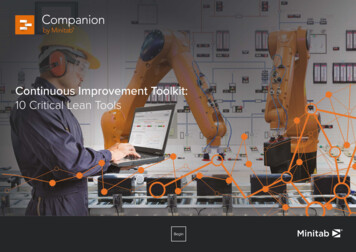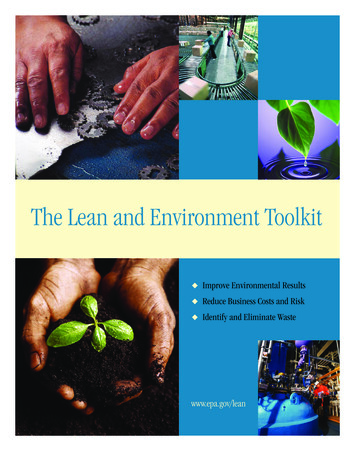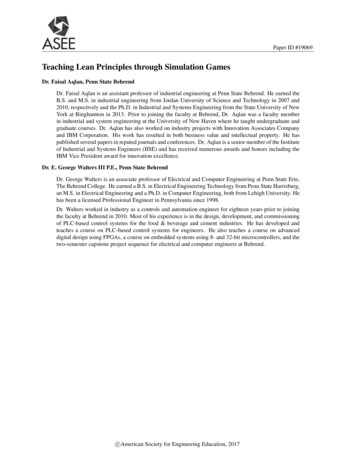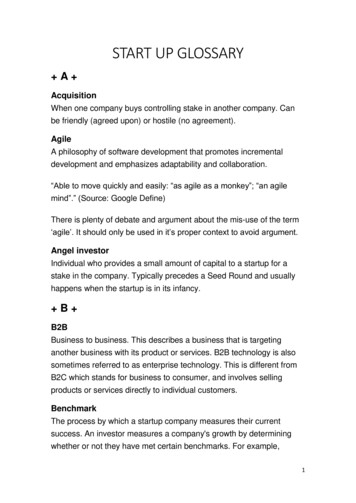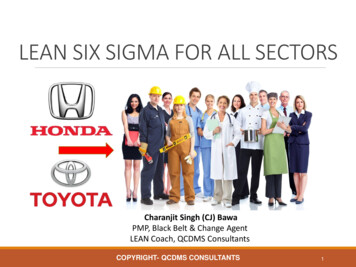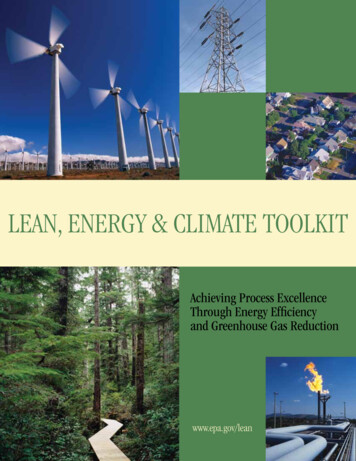
Transcription
LEAN, ENERGY & CLIMATE TOOLKITAchieving Process ExcellenceThrough Energy Efficiencyand Greenhouse Gas Reductionwww.epa.gov/lean
How to Use This ToolkitThis toolkit uses icons in the page margins to help you find andfollow important information in each chapter.Identifies an important point to rememberDefines an important term or conceptPresents a technique or resource that helps capture,communicate, or apply new knowledgeChapters also include one or more “To Consider” text boxesthat contain questions to help you explore how the informationrelates to your organization.
Lean, Energy & Climate ToolkitAcknowledgments The U.S. Environmental Protection Agency (EPA) is grateful for the invaluable assistance of theorganizations and individuals who helped develop this toolkit and shared experiences, tools, andtechniques for integrating Lean manufacturing and energy management efforts.EPA’s Lean and energy partners include Baxter International, California Manufacturing TechnologyConsulting (CMTC), Eastman Kodak Corporation, Eaton Corporation, General Electric (GE), HNICorporation, the National Institute of Standards and Technology (NIST) Manufacturing ExtensionPartnership (MEP), The Pew Center on Global Climate Change, and the U.S. Department of Energy.EPA’s Office of Policy and the Office of Chemical Safety and Pollution Prevention participated in thedevelopment of this toolkit.In addition to these organizational partners, this toolkit has benefited from the collective expertiseand ideas of many individuals. In particular, EPA would like to thank the following individuals fortheir thoughtful contributions:Susan Boone, Lean Six Sigma Trainer, GE InfrastructureJames Breeze, Energy Engineer/Project Leader, Worldwide Energy Office, Eastman KodakCompanyJenni Cawein, Corporate Environmental Health and Safety (EHS) Engineering Manager,Baxter InternationalGerald Church, Director of Energy Services, CMTCRob Currie, Director, Corporate EHS Engineering, Baxter InternationalMichelle Gaither, Technical Research Coordinator, Pacific Northwest Pollution PreventionResource CenterGretchen Hancock, Project Manager, GE Corporate Environmental ProgramsErnie Kulik, Corporate EHS, Eaton CorporationScott Lesnet, Member EHS Manager, HNI CorporationMike Molnar, Sustainability Manager, Cummins, Inc.Kirk Prather, Operations Manager Energy Services, CMTCDouglas W. Prihar, Management Assistance Partnership Project Director, Nevada System ofHigher EducationRandy Shultz, Facilities and EHS Manager, Eaton Truck, Shenandoah, IowaKen Somers, Senior Expert, McKinsey CorporationScott Summers, Director and Vice President, EHS, Film Products Group, Eastman KodakCompanyCarroll Thomas, Partnership Catalyst, NIST MEP
Walt Tunnessen, National Program Manager, ENERGY STARSarah Wendel, The Monterey Institute of International StudiesJoe Wolfsberger, Vice President of Corporate EHS, Eaton CorporationThis toolkit was prepared for the U.S. Environmental Protection Agency by Ross & Associates Environmental Consulting, Ltd. (http://www.ross-assoc.com) in association with Industrial Economics,Inc. (EPA Contract # EP-W-04-023).
Lean, Energy & Climate ToolkitTable of Contents Executive Summary.i Preface. iv Chapter 1Introduction .1 Benefits of Coordinating Lean and Energy Management.1 Cost Savings.2 Greenhouse Gas and Environmental Risk Management.2 Competitive Advantage.3 Chapter 2Integrating Lean, Energy Efficiency and Greenhouse Gas Management.5 Energy In-Line Management .5 Guidelines for Energy Management.5 Lean Windows of Opportunity for Energy Savings .7 Chapter 3Overview of Energy Use and Lean .9 Energy Sources and End Uses.9 Understand the Costs of Energy Use.10 Energy Efficiency Benefits of Lean Implementation.11 Chapter 4Energy and Greenhouse Gas Assessment Strategies .13 A. Observe Energy Use on the Shop Floor .13 B. Energy Audits and Measuring Energy Use .15 C. Greenhouse Gas Inventories.18 D. Examine Energy Use with Value Stream Mapping .19 E. Use Six Sigma to Find and Eliminate Energy Waste and Variation.23 Chapter 5Energy and Greenhouse Gas Emission Reduction Tools and Strategies.25 A. Conduct Energy Kaizen Events .25 B. Use Total Productive Maintenance to Reduce Equipment Energy Waste.27 C. Replace Over-Sized and Inefficient Equipment with Right-Sized Equipment.30 D. Design Plant Layout to Improve Flow and Reduce Energy Use.31 E. Encourage Energy Efficiency with Standard Work, Visual Controls, Employee Engagement and Mistake-Proofing.32 F. Reduce Greenhouse Gas Emissions through Transportation Efficiencies .36 Chapter 6Conclusion .41 Going Further with Clean Energy.41 The Lean and Energy Journey .42 Appendices .43 Appendix A: Energy and Greenhouse Gas Management Service Providers, Resources, and Tools .43 Appendix B: Sector-Focused Energy Reduction and Greenhouse Gas Management Resources.46 Appendix C: Energy Conversion Resources and Rules of Thumb for Estimating Energy Cost Savings.48
Lean, Energy & Climate ToolkitBoxesExample Results from Lean and Energy Improvement Efforts (Box 1) .i Benefits of Coordinating Lean, Energy and Greenhouse Gas Management (Box 2).1 Lean and Energy Use Reduction: Company Cost Savings Experience (Box 3) .2 Lean and Energy at Toyota (Box 4).4 Why Be Strategic About Energy Management (Box 5) .6 Energy End Uses: What Do We Use Energy To Do? (Box 6).10 Questions for Understanding Energy Use (Box 7) .14 Energy Treasure Hunts at General Electric (Box 8).15 Energy Savings (Box 9).16 Common Energy Units (Box 10) .17 Example Results from Value and Energy Stream Mapping Projects (Box 11) .20 Six Sigma and Energy Savings at Baxter International (Box 12).23 What Is An Energy Kaizen Event (Box 13).26 What Is TPM? (Box 14) .27 Strategies for Integrating Energy Reduction Efforts Into TPM (Box 15).28 Energy Reduction Checklist for Combustion, Steam Generation, and Process Heating Systems (Box 16) .29 Over-Sized Equipment (Box 17) .30 Three Ways to Right-Size Your Fan System (Box 18) .31 Flow and Energy Use (Box 19) .32 UPS: Fuel Efficiency Through Fleet Optimization (Box 20).38 Ways to Reduce Your Employees’ Commutes (Box 21) .39 FiguresFigure 1: ENERGY STAR Guidelines for Energy Management.6 Figure 2: Sources of Energy Used for U.S. Industry and Manufacturing, 2005 .9 Figure 3: Example Value Stream Map .21 Figure 4: Example Process Data Box with Energy Use Data.22 Figure 5: Example Visual Control.34 Figure 6: Dashboard Visual Controls.35 Figure 7: Materials Used by Cummins in Employee Engagement Energy-Reduction Efforts .35 Figure 8: Fuel Used for Transportation .37 TablesTable 1: Energy Use Hidden in Lean Wastes.12 Table 2: Top Ten Energy Reduction Recommendations .16 Table 3: Example Actions Identified at a Kaizen Event.26 Table 4: Example Energy Use Checklist.33
Executive SummaryExecutive Summary The U.S. Environmental Protection Agency (EPA) developed this Lean, Energy & Climate Toolkit toassist organizations in reducing greenhouse gas emissions and energy use while improving performance through Lean manufacturing activities. Drawing from the experiences and best practices ofindustry leaders, Lean and environmental service providers, and government partners, this toolkitprovides practical strategies and techniques for improving energy and environmental performancewhile achieving Lean goals such as improved quality, reduced waste, and increased customer responsiveness.There are many reasons to integrate Lean, energy efficiency and greenhouse gas reduction effortsincluding:1. Cost Savings: Reducing energy costs has a significant impact on business performance,though costs may be hidden in overhead or facility accounts.2. Greenhouse Gas Management and Environmental Risk: Proactively addressing theenvironmental and climate impacts of energy use is increasingly important to industry andsociety. Failure to do so is a potential business risk.3. Competitive Advantage: Lowering recurring operating costs, improving staff morale, andresponding to customer expectations for environmental performance and energy efficiencyincreases your competitive advantage.Linking Lean and Energy UseConsiderable energy savings typically go hand-in-hand with Lean activities because of Lean’s focuson eliminating non-value added activities (waste). Without explicit consideration of energy wastes,however, Lean may overlook significant opportunities to improve performance and reduce costs.Companies such as Baxter International, Eastman Kodak, General Electric, Toyota, and 3M, as wellas many other manufacturers, both large and small, have successfully used Lean methods to reduceenergy use, risks, and costs (see Box 1).Example Results From Lean and Energy Improvement Efforts (Box 1)3A Baxter International facility saved 300,000 in energy costs in one year.3General Electric reduced greenhouse gas emissions by 700,000 metrictons and saved 111 million in operating costs at facilities worldwide.3Toyota Motor Manufacturing North America reduced facility energy useand greenhouse gas emissions by 19 percent per vehicle since 2000.3Cummins, Inc. saved 1.2 million using visual cues to encourage employees to unplug during their holiday shutdowns.Lean manufacturing and its relationship to greenhouse gas management is also addressed in thistoolkit. Manufacturing companies who commit to reducing energy use are in turn committing toi
Executive Summaryreducing their greenhouse gas emissions, therefore reducing their impact on the environment andmitigating climate change. This toolkit describes a range of strategies for identifying Lean andenergy improvement opportunities and reducing energy use with Lean methods. With the use of thistoolkit, manufacturing companies can discover ways to lower their energy costs, improve their energy efficiency, and reduce their impact on the environment. It is not necessary to implement all thetechniques in the toolkit to succeed; instead, select and adapt the approaches that make the mostsense for your organization.Integrating Lean, Energy and Greenhouse Gas ManagementTo be most effective, Lean and energy efforts should be proactive, strategic, and systematic. Adoptingan energy management system and building an energy program that aligns with and supports yourorganization’s Lean initiatives will enable your organization to achieve the greatest improvementsin operational, energy, and environmental performance. Ideas discussed include: Energy In-Line Management Guidelines for Energy Management Lean Windows of Opportunity for Energy SavingsIn addition to explicitly using Lean methods to target energy wastes, facilities can take advantage ofother windows of opportunity for energy savings that arise during Lean, including opportunities toinstall energy-efficient equipment, switch to less polluting fuel sources, and design products to useless energy. To be most effective, Lean and energy efforts should be proactive, strategic, and systematic. Adopting an energy management system that aligns with and supports your organization’sLean initiatives will enable your organization to achieve the greatest improvements in operational,energy, and environmental performance.Assessment StrategiesLean, energy, and greenhouse gas assessment strategies involve observing shop-floor activities toidentify signs of energy waste and greenhouse gas emissions, measuring actual energy use and costsover time, and implementing energy savings opportunities through short, focused events. Strategiesdescribed in this toolkit include: Energy Treasure Hunts: Conduct a multi-day plant-wide assessment of energy savings opportunities using a cross-functional team of employees. Greenhouse Gas Inventories: Create a greenhouse gas inventory to help your companyunderstand your emissions reduction opportunities. Value and Energy Stream Mapping: Integrate energy-use analysis into the Lean valuestream mapping process to identify improvement opportunities within the context of theentire “value stream” of a product or service. Six Sigma: Use statistical process analysis and control tools to find and address root causesof greenhouse gas emissions and energy wastes and variation.ii
Executive SummaryEmissions Reduction StrategiesMany energy efficiency and greenhouse gas reduction best practices can be implemented withoutextensive analysis or planning. The Lean and energy reduction strategies in this toolkit describeways to reduce energy use and greenhouse gases through Lean activities such as the following: Energy Kaizen Events: Identify and implement employee ideas for saving energy andreducing wastes through rapid process improvement events. Total Productive Maintenance (TPM): Incorporate energy reduction best practices intoday-to-day autonomous maintenance activities to ensure that equipment and processes runsmoothly and efficiently. Right-Sized Equipment: Identify and replace oversized and inefficient equipment withsmaller equipment tailored to the specific needs of manufacturing cells. Plant Layout and Flow: Design or rearrange plant layout to improve product flow whilealso reducing energy use and associated impacts. Standard Work, Visual Controls, Employee Engagement and Mistake-Proofing:Sustain and support additional Lean and energy performance gains through standardizedwork, procedures and visual signals that encourage energy conservation, and by making iteasy or “mistake-proof” to be energy efficient. Transportation Efficiencies: Look at your company’s transportation fleet and mobileequipment to see if there are opportunities to improve routes, reduce idling, minimize thenumber of trips, and improve overall efficiency of the fleet.Going Further with Lean and EnergyCompanies are increasingly taking additional steps to reduce and offset the environmental andclimate impacts of their energy use. These activities look beyond standard operational practices. Afew ideas for going further include: Purchasing Green Power: Many utilities offer customers the opportunity to purchasepower that is generated from renewable sources or “green power.” Carbon Offsets: Some organizations have committed to supplement their efforts to reduceenergy consumption by offsetting the carbon emitted to the atmosphere by the energy thatthey do use.iii
PrefacePreface Purpose of This Toolkit This Lean, Energy & Climate Toolkit offers Lean implementers practical strategies and techniques for enhancing Lean results—waste elimination, quality enhancement, and delivery ofvalue to customers—while improving energy efficiency and reducing energy use, greenhouse gasemissions, costs, and risk. The toolkit is also intended to introduce Lean practitioners to the extensive array of energy management resources available from EPA, the U.S. Department of Energy(DOE), and other organizations.The “Lean” methods discussed in this toolkit are organizational improvement methods pioneeredin the Toyota Production System. Lean production and Lean manufacturing refer to a customerfocused business model and collection of methods that focus on the elimination of waste (non-valueadded activity) while delivering quality products on time and at a low cost. The toolkit assumes thatyou are familiar with Lean methods. For those who want to learn more about Lean, see EPA’s Leanand Environment website (www.epa.gov/lean).This toolkit provides strategies and information that can be used throughout your Lean, Energy andGreenhouse Gas Management journey. Chapters 1-3 help you understand the relationship of Leanto energy use, the benefits of systematically reducing energy use through Lean and ways to integrateenergy efficiency and greenhouse gas management efforts into your organization’s business strategyand management practices. Chapters 4-6 describe how to identify and implement energy savingsopportunities in the context of Lean. These strategies leverage Lean methods such as value streammapping, kaizen events, total productive maintenance, and standard work to improve energy andoperational performance, while also incorporating energy assessment and reduction tools that canenhance Lean implementation.Key Questions Addressed by This ToolkitLean focuses on identifying and eliminating waste. Environmental improvement and energyreduction efforts that distract from classic Lean efforts may not get much traction. By contrast,this toolkit contains strategies and techniques that can enable Lean practitioners to easily identifyenergy wastes and improvement opportunities alongside traditional Lean wastes and improvementopportunities. To accomplish this, the toolkit aims to answer the following questions:What is the relationship between Lean and energy use and climate change?Energy savings and greenhouse gas reductions are often obtained during traditional Lean events,but by explicitly focusing on energy use you can get substantially greater energy improvements. Byeliminating manufacturing wastes, such as unnecessary processing and transportation, businessesreduce the energy needed to power equipment, lighting, heating, and cooling. Chapter 1 describesbenefits of combining Lean, energy improvement, and greenhouse gas reduction efforts. Chapters 2iv
Prefaceand 3 explore the relationship between Lean and energy use, and provide background informationon energy use and costs.How do you know how much energy is used in a facility and where it isbeing used?A key step in effective Lean and energy efforts is learning where to target energy-reduction activities.Chapter 4 discusses techniques for assessing energy use and greenhouse gas emissions reductions,identifying opportunities to save energy in the context of Lean. Methods include energy treasurehunts, greenhouse gas inventories, value stream mapping, and Six Sigma.How can you reduce energy use and greenhouse gas emissions withLean methods?Chapter 5 examines specific opportunities for using Lean to improve energy efficiency and reducegreenhouse gas emissions, including methods such as kaizen events, total productive maintenance,right-sized equipment, plant layout, standard work, transportation efficiency and visual controls.v
Lean, Energy & Climate Toolkit
CHAPTER 1 Introduction Coordinating Lean, Energy and Greenhouse Gas Management is a powerful way to reduce costs.This chapter includes: Benefits of Coordinating Lean Energy and Greenhouse Gas Management Cost Savings Greenhouse Gas and Environmental Risk Management Competitive AdvantageBenefits of Coordinating Lean andEnergy ManagementEnergy is a vital (and often costly) input to most production processes and value streams. By thinking explicitly about unnecessary energy use as another “waste,” Lean implementers can significantlyreduce costs and enhance competitiveness, while also achieving environmental performance goals.Benefits of Coordinating Lean, Energy & Greenhouse Gas Management(Box 2)3 Reduce operating and maintenance costs3 Reduce vulnerability to energy and fuel price increases3 Meet customer expectations3 Enhance productivity3 Improve safety3 Improve employee morale and commitment3 Improve environmental quality3 Reduce greenhouse gas emissions3 Remain below air permitting emission thresholds3 Increase overall profitMany organizations can find it difficult to get senior managers to focus attention on energy use,since it is often viewed as a necessary cost of doing business and is accounted for as overhead. Bylinking energy management and greenhouse gas reduction efforts to Lean activities, these activitiescan be tied more directly to process improvement efforts that are regarded by senior managers asbeing vital to business success.1
Chapter 1: IntroductionCost SavingsEnergy costs can have a significant impact on the financial performance of businesses. A 2009survey of corporations conducted by Siemens found that energy cost savings are the top driver forcorporate sustainability efforts and seventy-two percent of all respondents reported that loweredoperating costs were the reason their firms participated in sustainability initiatives in general.1Lean and Energy Use Reduction:Company Cost Savings Experience (Box 3) 3 Eastman Kodak Company (New York) conducted energy kaizen eventsthat significantly reduced energy use and resulted in overall savings of 15 million between 1999 and 2006.3 General Electric (Ohio) achieved cost savings of over 1 million at onefacility due to fuel use reductions realized through Lean implementation.3 Howard Plating (Michigan) reduced energy use by 25 percent through aLean implementation effort.3 Lasco Bathware (Washington) eliminated the need for a shrink-wrapoven when planning for a Lean event, reducing natural gas consumptionby 12.6 million cubic feet and saving about 99,000.3 Naugatuck Glass Company (Connecticut) used Lean to cut product leadtime and improve quality, while also reducing energy use by 19 percent.3 Steelcase Inc. (California) used Lean to improve operations, reducingfixed utility costs (including energy) by about 90 percent.Energy use and cost information is, however, often decentralized and hidden from view in overhead or facilities accounts. Explicitly considering energy use in Lean implementation can revealthese hidden cost-reduction opportunities. Many companies have achieved significant cost savingsas a result of energy reductions from Lean implementation. Reducing energy use and increasingenergy efficiency is a proven strategy for cutting and controlling costs.Greenhouse Gas and Environmental Risk ManagementThe environmental and climate impacts of energy use are a major issue facing industry and society.Carbon dioxide (CO2), a major greenhouse gas, is emitted to the atmosphere directly when fuels arecombusted on-site and indirectly when electricity is consumed (particularly when fossil fuels areused to generate the electricity). Emissions also occur when fuel is combusted during transportation of goods to and from facilities and within. Lean methodologies can help companies with an1Siemens (2009). Greening of Corporate America: The Pathway to Sustainability from Strategy to Action. McGraw-Hill Construction.2
Chapter 1: Introductioneffective way to identify opportunities to improve efficiency and reduce greenhouse gas emissions.This reduces business risks associated with greenhouse gas emissions and contributes to reductiontargets.Carbon dioxide is not the only by-product of energy use. On-site combustion of fuels in boilers,ovens, vehicles, and equipment can emit a variety of regulated pollutants, including carbon monoxide (CO), sulfur dioxide (SO2), nitrogen oxide (NOX), particulate matter (PM), volatile organiccompounds (VOCs), and a variety of air toxics.Combustion pollutant emissions can affect worker health, and trigger the need for costly permitting,monitoring, and emission controls. More broadly, reducing air emissions from combustion activities can help protect neighboring communities and public health. Storage and handling of fuelsalso pose a variety of worker health, safety, and environmental costs and risks, even in the absenceof spills. Lean efforts can directly target and mitigate these impacts and risks.Competitive AdvantageIdentifying and eliminating energy waste through Lean can improve a company’s ability to competein several ways. First, reducing the energy intensity of production activities and support processesdirectly lowers recurring operating costs with direct bottom line and competitiveness impacts.When asked by the Economist how the recent economic downturn would affect companies’ approaches to carbon reduction, 47 percent of respondents stated they planned to improve their focusas a cost saving measure.2Second, eliminating energy waste and the associated environmental impacts through Lean canfoster competitive advantage for some businesses. Customers and employees may view proactiveenvironmental improvement efforts as an important attribute, affecting customer loyalty and theability to attract and retain employees. Participation in climate partnership programs or
organizations and individuals who helped develop this toolkit and shared experiences, tools, and techniques for integrating Lean manufacturing and energy management efforts. EPA’s Lean and energy partners include Baxter International, California Manufacturing Technology Consulting (CMTC),
